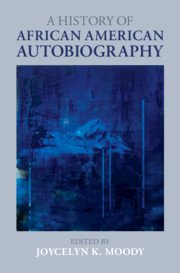Book contents
- A History of African American Autobiography
- A History of African American Autobiography
- Copyright page
- Contents
- Illustrations
- A Chronology of African American Life Writing
- Contributors
- Chapter 1 Crafting a Credible Black Self in African American Life Writing
- Part I Origins and Histories
- Part II Individuals and Communities
- Chapter 12 Spiritual Autobiography, Past and Present
- Chapter 13 Life Writings of Contemporary African American Women
- Chapter 14 The Autobiography of Malcolm X as a Transitional Black Arts Text
- Chapter 15 Black Queer Life Writing
- Chapter 16 African American Celebrity Auto/Biographies
- Chapter 17 Mixed-Race Autobiographical Narratives
- Chapter 18 Black Biography, Past and Present
- Chapter 19 Black Lives in Contemporary Persona Poems
- Chapter 20 Depicting African American Life in Graphics and Visual Cultures
- Chapter 21 Life Writing for Black Children and Youth
- Chapter 22 Black Life Writing for Young Readers
- Chapter 23 Can Cups Be Books? Or, Other Ways to Recognize African American Autobiography
- Index
Chapter 14 - The Autobiography of Malcolm X as a Transitional Black Arts Text
from Part II - Individuals and Communities
Published online by Cambridge University Press: 30 September 2021
- A History of African American Autobiography
- A History of African American Autobiography
- Copyright page
- Contents
- Illustrations
- A Chronology of African American Life Writing
- Contributors
- Chapter 1 Crafting a Credible Black Self in African American Life Writing
- Part I Origins and Histories
- Part II Individuals and Communities
- Chapter 12 Spiritual Autobiography, Past and Present
- Chapter 13 Life Writings of Contemporary African American Women
- Chapter 14 The Autobiography of Malcolm X as a Transitional Black Arts Text
- Chapter 15 Black Queer Life Writing
- Chapter 16 African American Celebrity Auto/Biographies
- Chapter 17 Mixed-Race Autobiographical Narratives
- Chapter 18 Black Biography, Past and Present
- Chapter 19 Black Lives in Contemporary Persona Poems
- Chapter 20 Depicting African American Life in Graphics and Visual Cultures
- Chapter 21 Life Writing for Black Children and Youth
- Chapter 22 Black Life Writing for Young Readers
- Chapter 23 Can Cups Be Books? Or, Other Ways to Recognize African American Autobiography
- Index
Summary
Smethurst argues that the Autobiography of Malcolm X has deep roots in earlier African American autobiography, particularly the Christian conversion narrative and the slave narrative, notably the three life narratives of Frederick Douglass. For Smethurst, the defining chiasmus of Douglass’s first autobiographical narrative, “You have seen how a man was made a slave; you shall see how a slave was made a man,” structures The Autobiography, too — at least until Malcolm’s integration into the structure, theology, and ideology of the Nation of Islam. Smethurst argues that The Autobiography also follows Douglass’s three life narratives in that each of the latter not only retells the story chronicled in the first narrative but also unveils Douglass’s evolving positions, his developing political literacy, through later political moments, the Civil War, Reconstruction, and the early rise of Jim Crow. The Autobiography does not project an end of the development with Malcolm X’s conversion to the Nation of Islam, but a continuing transition, his grappling with the rapidly changing domestic and international political and cultural environments of the 1960s.
Keywords
- Type
- Chapter
- Information
- A History of African American Autobiography , pp. 224 - 238Publisher: Cambridge University PressPrint publication year: 2021

